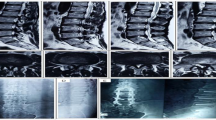Abstract
Introduction
There is no comparative study regarding surgical outcomes between microsurgical extraforaminal decompression (MeFD) and posterior lumbar interbody fusion (PLIF) for the treatment of lumbar foraminal stenosis (LFS). Therefore, the purpose of this study was to compare the surgical outcomes of LFS using two different techniques: MeFD alone or PLIF.
Methods
For the purposes of this study, a prospectively collected observational cohort study was conducted. Fifty-five patients diagnosed with LFS who were scheduled to undergo spinal surgery were included in this study. According to the chosen surgical technique, patients were assigned to either the MeFD group (n = 25) or the PLIF group (n = 30). The primary outcome was Oswestry Disability Index (ODI) score at 1 year after surgery.
Results
The baseline patient characteristics and preoperative ODI score, visual analog scale (VAS) scores for back and leg pain, and Short Form-36 score were not significantly different between the two groups. At 12 months postoperative, the mean ODI score in the MeFD and PLIF groups was 25.68 ± 14.49 and 27.20 ± 12.56, respectively, and the 95 % confidence interval (−9.76–6.73) was within the predetermined margin of equivalence. The overall ODI score and VAS scores for back and leg pain did not differ significantly over the follow-up assessment time between the two groups. However, the ODI score and VAS scores for back and leg pain improved significantly over time after surgery in both groups. In the MeFD group, revision surgery was required in three patients (12 %).
Conclusions
This study demonstrated that MeFD alone and PLIF have equivalent outcomes regarding improvement in disability at 1 year after surgery. However, the higher rate of revision surgery in the MeFD group should emphasize the technically optimal amount of decompression.





Similar content being viewed by others
References
Papavero L, Kothe R (2013) Microsurgical extraforaminal decompression of lumbar root canal stenosis. Operative Orthopadie und Traumatologie 25(1):16–30. doi:10.1007/s00064-012-0194-3
Yoshimoto M, Takebayashi T, Kawaguchi S, Tsuda H, Ida K, Wada T, Suzuki D, Yamashita T (2011) Minimally invasive technique for decompression of lumbar foraminal stenosis using a spinal microendoscope: technical note. Minim Invasive Neurosurg 54(3):142–146. doi:10.1055/s-0031-1279716
Yamada K, Matsuda H, Nabeta M, Habunaga H, Suzuki A, Nakamura H (2011) Clinical outcomes of microscopic decompression for degenerative lumbar foraminal stenosis: a comparison between patients with and without degenerative lumbar scoliosis. Eur Spine J 20(6):947–953. doi:10.1007/s00586-010-1597-1
Chang HS, Zidan I, Fujisawa N, Matsui T (2011) Microsurgical posterolateral transmuscular approach for lumbar foraminal stenosis. J Spinal Disorders Tech 24(5):302–307
Matsumoto M, Watanabe K, Ishii K, Tsuji T, Takaishi H, Nakamura M, Toyama Y, Chiba K (2010) Posterior decompression surgery for extraforaminal entrapment of the fifth lumbar spinal nerve at the lumbosacral junction. J Neurosurg Spine 12(1):72–81. doi:10.3171/2009.7.SPINE09344
Ozeki N, Aota Y, Uesugi M, Kaneko K, Mihara H, Niimura T, Saito T (2008) Clinical results of intrapedicular partial pediculectomy for lumbar foraminal stenosis. J Spinal Disorders Tech 21(5):324–327
Jenis LG, An HS (2000) Spine update. Lumbar foraminal stenosis. Spine (Phila Pa 1976) 25(3):389–394
Hallett A, Huntley JS, Gibson JN (2007) Foraminal stenosis and single-level degenerative disc disease: a randomized controlled trial comparing decompression with decompression and instrumented fusion. Spine (Philadelphia, Pa 1976) 32(13):1375–1380
Infusa A, An HS, Glover JM, McGrady L, Lim TH, Riley LH 3rd (1996) The ideal amount of lumbar foraminal distraction for pedicle screw instrumentation. Spine (Phila Pa 1976) 21(19):2218–2223
Katz JN, Harris MB (2008) Clinical practice. Lumbar spinal stenosis. N Engl J Med 358(8):818–825
Watters WC 3rd, Baisden J, Gilbert TJ, Kreiner S, Resnick DK, Bono CM, Ghiselli G, Heggeness MH, Mazanec DJ, O’Neill C, Reitman CA, Shaffer WO, Summers JT, Toton JF, North American Spine S (2008) Degenerative lumbar spinal stenosis: an evidence-based clinical guideline for the diagnosis and treatment of degenerative lumbar spinal stenosis. Spine J 8(2):305–310. doi:10.1016/j.spinee.2007.10.033
Schizas C, Theumann N, Burn A, Tansey R, Wardlaw D, Smith FW, Kulik G (2010) Qualitative grading of severity of lumbar spinal stenosis based on the morphology of the dural sac on magnetic resonance images. Spine (Philadelphia, Pa 1976) 35(21):1919–1924
Bernhardt M, White A, Panjabi M (1992) Biomechanical considerations of spinal stability. The spine. WB Saunders, Philadelphia
Wang JC, Mummaneni PV, Haid RW (2005) Current treatment strategies for the painful lumbar motion segment: posterolateral fusion versus interbody fusion. Spine (Phila Pa 1976) 30(16 Suppl):S33–S43
Enker P, Steffee AD (1994) Interbody fusion and instrumentation. Clin Orthop Relat Res 300:90–101
Fairbank JC, Pynsent PB (2000) The Oswestry disability index. Spine (Philadelphia, Pa 1976) 25(22):2940–2952
Ware J, Snow K, Kosinski M, Gandek B (1993) SF-36 health survey manual and interpretation guide. New England Medical Center, The Health Institute, Boston
Ostelo RW, Deyo RA, Stratford P, Waddell G, Croft P, Von Korff M, Bouter LM, de Vet HC (2008) Interpreting change scores for pain and functional status in low back pain: towards international consensus regarding minimal important change. Spine (Phila Pa 1976) 33(1):90–94. doi:10.1097/BRS.0b013e31815e3a10
Katz JN, Lipson SJ, Lew RA, Grobler LJ, Weinstein JN, Brick GW, Fossel AH, Liang MH (1997) Lumbar laminectomy alone or with instrumented or noninstrumented arthrodesis in degenerative lumbar spinal stenosis. Patient selection, costs, and surgical outcomes. Spine (Phila Pa 1976) 22(10):1123–1131
Katz JN (2001) Patient preferences and health disparities. JAMA J Am Med Assoc 286(12):1506–1509
Conflict of interest
The authors have no conflict of interest to declare.
Author information
Authors and Affiliations
Corresponding author
Rights and permissions
About this article
Cite this article
Kim, HJ., Jeong, JH., Cho, HG. et al. Comparative observational study of surgical outcomes of lumbar foraminal stenosis using minimally invasive microsurgical extraforaminal decompression alone versus posterior lumbar interbody fusion: a prospective cohort study. Eur Spine J 24, 388–395 (2015). https://doi.org/10.1007/s00586-014-3592-4
Received:
Revised:
Accepted:
Published:
Issue Date:
DOI: https://doi.org/10.1007/s00586-014-3592-4




